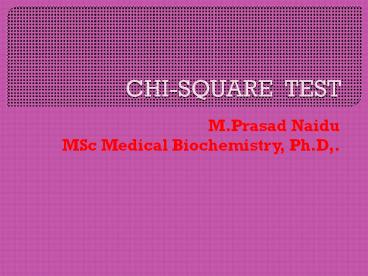chi sqyre test.pptx - PowerPoint PPT Presentation
Title:
chi sqyre test.pptx
Description:
Biochemistry – PowerPoint PPT presentation
Number of Views:34
Title: chi sqyre test.pptx
1
CHI-SQUARE TEST
- M.Prasad Naidu
- MSc Medical Biochemistry, Ph.D,.
2
CHI-SQUARE TEST
- It is a non parametric test , not based on any
assumption or distribution of any variable. - It is very useful in research and it is most
commonly used when the data are given in
frequencies . - It can be used with any data which can be reduced
to proportion or percentages. - This test involves calculation of quantity called
chi- square , which derived from Greek letter (
?)² and pounced as kye. Cont
3
2
- It is an alternate test to find the significance
of difference in two or more than two
proportions. - Chi square test is yet another useful test which
can be applied to find the significance in the
same type of data with the following advantages .
- cont
4
3
- To compare the values of two binomial samples
even if they are small such as incidence of
diabetes in 20 obese persons with 20 non obese
persons. - To compare the frequencies of two multinomial
samples such as number of diabetes and non
diabetes in groups weighing 40-50, 50-60, 60-70,
and gt 70 kg s of weight.
5
4.TEST OF ASSOCIATION
- Test of association between events in binomial
or multinomial samples . - Two events often can be tested for their
association such as cancer and smoking . - Treatment and outcome of disease .
- Vaccination and immunity .
- Nutrition and intelligence .
- Cholesterol and heart disease .
- Weight and diabetes, B P and heart disease.
- To find they are independent of each other or
dependent on each other i.e. associated .
6
5.Caliculation of chi-square value
- Three essentials to apply chi - square test are
- A random sample
- Qualitative data
- Lowest frequency not less than 5
- Steps -
- Assumption of Null Hypothesis (HO)
- Prepare a contingency table and note down the
observed frequencies or data (O) -
cont
7
6
- Determine the expected number (E) by multiplying
CT RT /GT (column total ,row total and grand
total ) - Find the difference between observed and expected
frequencies in each cell (O-E) - Calculate chi- square value for each cell with
- (O-E)²/E
- Sum up all chi square values to get the total
chi-square value (?)² d.f. (degrees of freedom) - ?² ?(O-E)²/E and d.f. is (c-1) (r-1)
8
7.Restractions in Application of (?)²
- Chi- square test applied in a four fold table
will not give reliable result , with one degree
of freedom. - If the observed value of any cell is lt 5 in such
cases Yates correction can be applied by
subtracting ½ (?)² ? (O-E-1/2)²/E - Even with Yates correction the test may be
misleading if any expected value is much below 5
in such cases Yates correction can not be
applied. -
cont
9
8
- In tables larger than 2 2 Yates correction can
not be applied . - The highest value of chi- square ?² obtainable by
chance or worked out and given in (?)² table at
different degrees of freedom under probabilities
(P) such as 0.05, 0.01, 0.001 . - If calculated value of chi-square of the sample
is found to be higher than the expected value of
the table at critical level of significance i.e.
probability of 0.05 the H O of no difference
between two proportions or the H O of
independence of two characters is rejected. - If the calculated value is lower the hypothesis
of no difference is accepted.
10
9.Exercise with out come results
- Groups Died Survived
Total - A (a) 10 (b)
25 35 - B (c) 5 (d)
60 65 - Total 15
85 100 - Expected value can be computed with CTRT/GT for
(a) 1535/100 5.25 - (b) 8535/100 29.75
- (c) 1565/100 9.75
- (d) 8565/100 55.25
11
10.Caliculation of Chi-square value
- ?² ?(O-E)²/E d.f. ( c-1) (r-1)
- (A) (10-5.25)²/5.25 (4.75)²/5
4.30 - (B) (25-29.75)²/29.75 (5)²/29.75 0
.76 - (C) (5-9.75)²/9.75 (5)²/9.75
2.31 - (D) (60-55.25)²/55.25 (5)²/55.25
0.40 -
7.77 - The calculated chi- square value is 7.77 is more
than - Chi- square table value with 1 d.f. At 0.01,
6.64 which significant. It can be said that
there is significant difference between two
groups.
12
12.Method -2
- Chi- square can be calculated in the following
way also. - (?)² ( ad-bc)²N
- (a b c d ac b d) (600-125
)² -
( 35 65 15 85) - (475)² x100 225625 00
/2900625 - (2900625) 7.77
- Here the calculated chi-square value7.77 is gt
6.64 at - 0.01 with 1 d.f. shows significant difference b/n
groups. So P is lt0.01
13
THANK YOU































